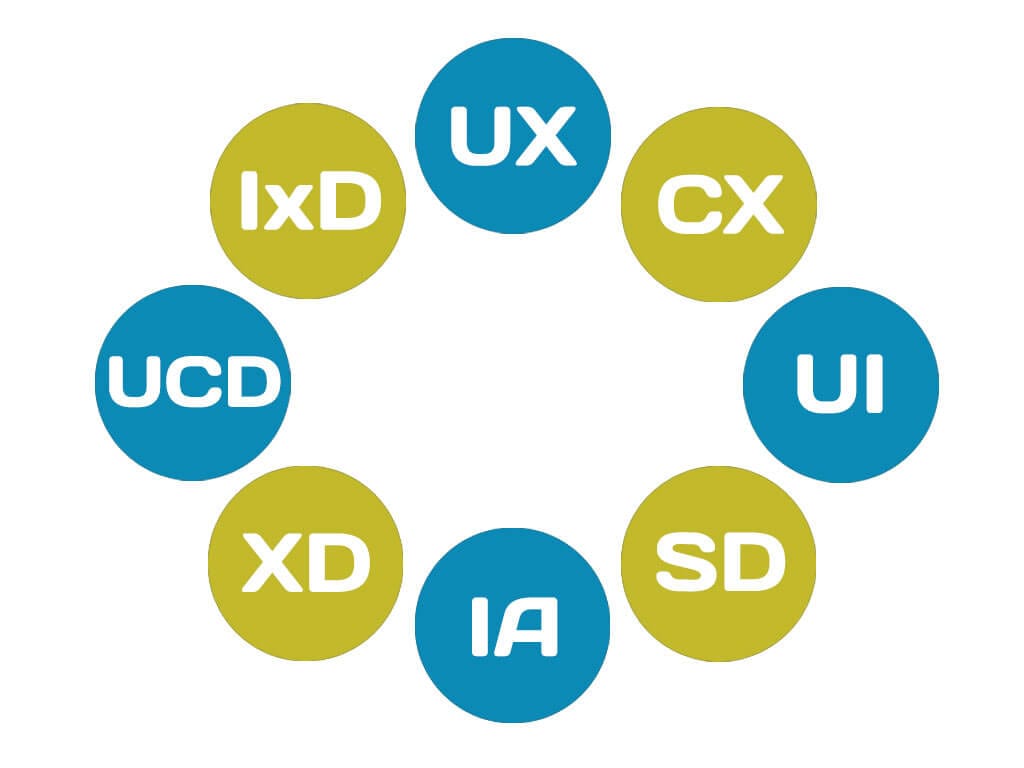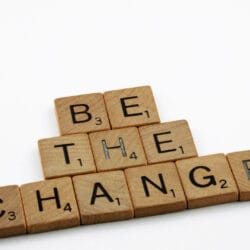About Changemaker The minimalists, Joshua & Ryan, help millions of people learn to live better…
Are you confused as to what UX, UI, CX, SD, IxD, and many other experience design acronyms mean today? You are not alone. So, let’s make it easier. Party time.
In the new world of hip acronyms, it’s easy to get lost.
You may well have heard of the likes of UX, UI, CX, SD, IxD, and maybe even UXD, IA, UCD, and more.
You may also have read about them all before, yet are still confused with conflicting information coming from eager young designers and bloggers who have themselves picked up pieces of information from all over the place and tried to make sense of it. You can’t blame them, they just want to know, but it’s messy. Titles change by the day.
What Is UX UI CX…Wait Why Should I Listen To You?
Having been in the industry as an independent freelancer for many years, I’ve been fortunate enough not to get too sucked into the world of acronyms as to become too confused by it all.
Yet, this is not unique to the design industry. There’s a whole load of acronyms and jargon that flutter about with titles created by the day to try and explain people’s skills and worth.
I’ve almost resorted to just saying, ‘Hi, I’m Richly, I’m human’, and drop the titles altogether, but then when someone wants to know what it is you can do it’s not long until the titles and acronyms emerge like a display of credentials again.
If you work in industries it becomes not just common knowledge but essential practice to know what they mean. If you don’t keep up you risk sounding like an amateur winging it. So, in that sense, it’s ‘quite’ important to know what they mean.
Now some of the definitions you may have encountered will be right, if not vague (by definition ha). Others not so much. Yet, what seems to be missing is a way for people to truly understand how these titles or acronyms work together.
So, I’m going to try and clear this up and make it much easier to understand in the form of a story, well a party actually.
So, let’s begin and get this party started.
What Is UX? (User Experience)

Why start with UX? Well, it’s probably the most commonly known acronym. Think of it as the Facebook, the first kid on the block to make a monopoly (sorry MySpace).
Let’s pretend all our acronyms are little animated characters with faces wearing a big onesie with their acronym on it.
UX is the party motivator.
The Forward-Thinking Challenge Course

Join our foundational course that will help you think differently and ahead of the curve, with actionable challenges that help bring a forward-thinking, adaptable and innovative edge to your life, business, or brand. Learn More
UX is all about feeling good, and likes to make sure everyone else at the party feels good, that their experience is going well. UX goes around the party asking questions, building up the personas of the guests, and trying to ensure everyone at the party is having a good time.
Of course, UX might not be able to make everyone happy but she will try her damnest to emphasize with everyone and to make sure she can understand what’s gone wrong if someone isn’t enjoying themselves.
UX isn’t just a chatterbox though, she is an analytical queen who wants to fix stumbling blocks in user flows and journeys. The experience from start to finish should be good for all involved, but most of all UX wants to make sure people leave the party knowing they’ve had a great time and to analyze the findings to ensure it can be improved and iterated even more for the next time.
Was there a segment of the party’s flow that was losing people’s interest? Could they not find the place easily? Was there not enough drink to keep people happy? Was there not a way to allow the partygoers to share their good time with others and spread the word easily?
UX is all over it. She is putting all the information together ready to see where the party could be improved through concentrating on the user’s experience, but this party is not online, this is in real-time.
Wait? What? I thought UX was all about a digital user experience. How someone interacts with a website or something?
Well, it is that, but it’s really about the whole cross-channel experience. In fact, UX, long before the term UX existed, and before products and services became digital, was simply about the overall experience or interaction with a company, or its services or products.
So, why does UX get misunderstood as just being a digital dancer when in fact UX works through any medium or space?
Well, UX stands for user experience, and not people’s experience or customer experience (more on that here). We associate a user with online use. We call offline users customers but online users, err, users. Why? That I don’t know, and that’s part of the confusion and is why it’s mistakenly associated with only online experiences. Maybe it’s something to do with how addictive technology is ha.
All you need to know is UX is interested in the whole end-user experience, offline and online. UX is as interested in how a customer goes through a bank to find a service as they are in how a user interacts with a website sales page.
The key focus is on the ‘end’ element. It’s about what is delivered to the end-user. It’s not about how the experience is for the other stakeholders.
Anyway, before this turns into a novel, let’s move on to the second character, UI.
What Is UI? (User Interface)
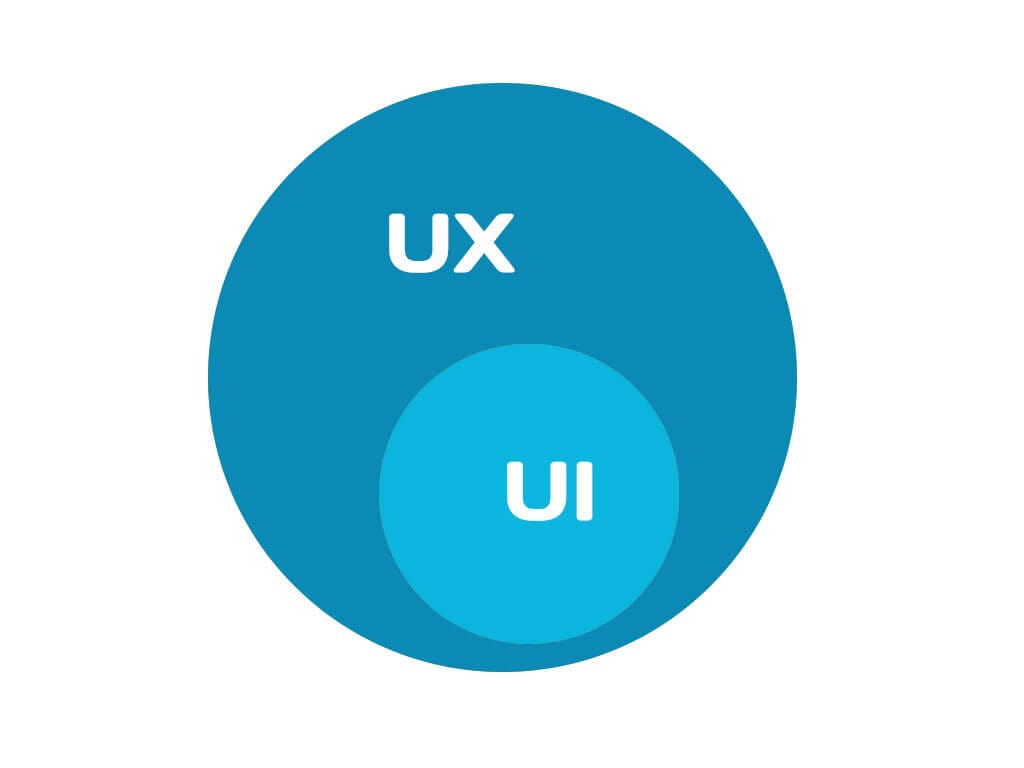
UI is the brother of UX. To some, they might seem like two peas in a pod, but look a bit closer and they have quite distinctively different personalities, even if they sometimes tread on each other’s toes.
UI isn’t really as talkative or interested in analyzing. UI is more interested in aesthetic interactions. UI is an artist who likes to talk through his art. He wants to make sure people understand his art and can find all secret passageways to his art easily.
For the party UI was in charge in making sure the house was well lit up and easy to find, that toilets are well signposted, and that there’s not a load of clutter for people to fall over in the house. UI does want to make sure partygoers have a good experience but does it through visual communication.
Now, this might be where people mistake UI for UX but UI is more of a specialist focused on all things visual. He is an artist. UX is more of a scientist, who can see and understand UI’s art but wants to ensure the user’s journey is catered for through that art.
If the party didn’t have all the lights and easy instructions set out in a visual way then partygoers would get lost, and maybe a bit boring. Neither UX or UI would like that. UX would feel that one part of the journey has let the whole experience down, and UI would take it personally like their art wasn’t clear enough for others to understand.
It then becomes in their best interests to work together on creating a great empathetic and visual experience for partygoers. UI will focus down on the aesthetics, navigation, and layout, ensuring any complex message is delivered easily so even drunk revelers can understand it, while UX will ensure the general flow of the experience is, err, flowing.
UX may have a bigger picture mindset of the overall user experience, while UI covers more specific skills within that experience.
What Is CX? (Customer Experience)
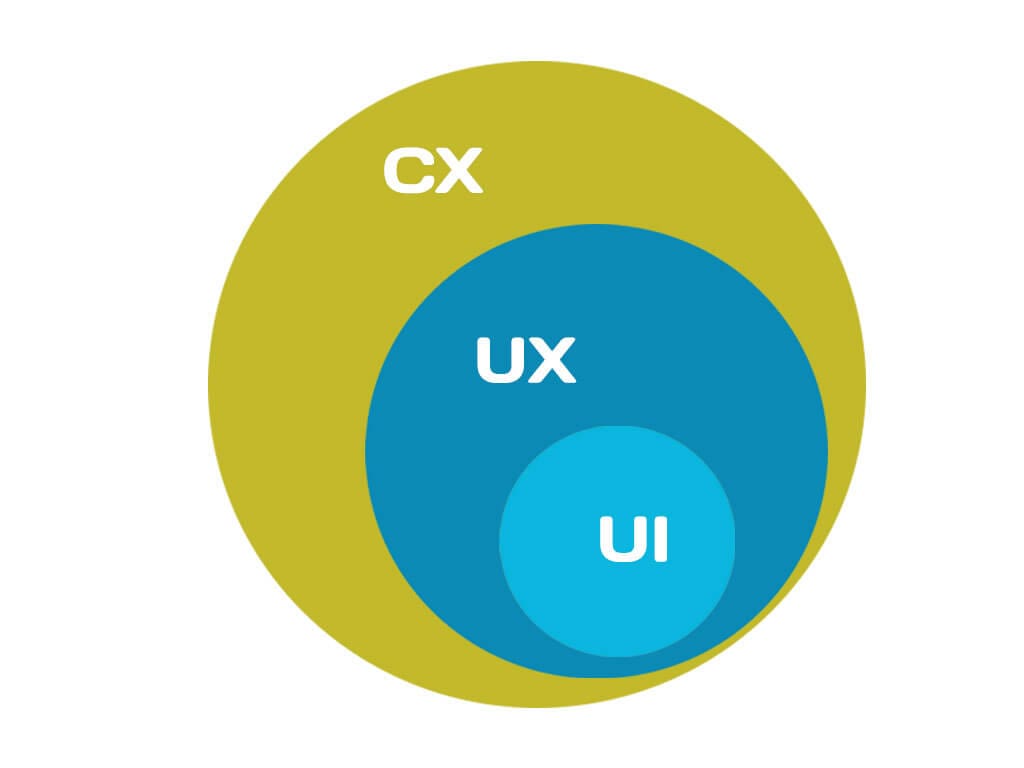
Here’s a much older partygoer. We’ve all heard of customer experience. CX was around before UX and UI were given names. In fact, UX really is just a more focused element of CX.
If we consider how UX was concerned with ensuring that partygoers were able to spread the word of the party easily, then CX is more concerned with what they say when they do.
Of course, UX wants to make sure the party was good too, but it becomes CX’s job to take on board the whole interaction with the brand, or in this case the party.
UX likes to analyze the active experience and touchpoints at different points of interaction or journey, but CX is like a feedback master. CX cares about ALL the interactions through the sales experience (of getting the party tickets), the customer service (did they enjoy the party AND the aftercare etc.), and the product design (the party’s theme).
CX is still focused on the customer experience on the whole but takes it further than UX in a broader sense, as CX wants to see how the feedback can affect the brand or company on the whole. If the customers didn’t have a good experience they might give bad feedback and we’d have to deal with the potential damage that might have on our brand (would people come back to the party again?).
Without a channel to be able to interact directly with the partygoers, CX wouldn’t know what they want, even if they had a good experience at the venue (which UX is focused on), and if a partygoer left their bag at the party and had no way to call up and get it back they would likely end up feeling they had a pretty bad experience.
CX needs to ensure there’s a direct line available between the customer and CX, so they give good feedback that portrays a strengthened brand. CX then focuses on making sure the party is dependable and has a good reputation, so more people come and give good feedback etc.
You can think of CX as the enabler of good word of mouth of a brand or company on the whole. She is in control of that total immersive experience the partygoer has and therefore can help determine whether the message spread will be good or not.
CX is like the manager of the interaction, the front-of-house host of the party. In the real world away from the party, this includes ‘the interactions that take place as customers discover, evaluate, buy, access, use, get support, reengage, and leave’.
What Is SD? (Service Design)
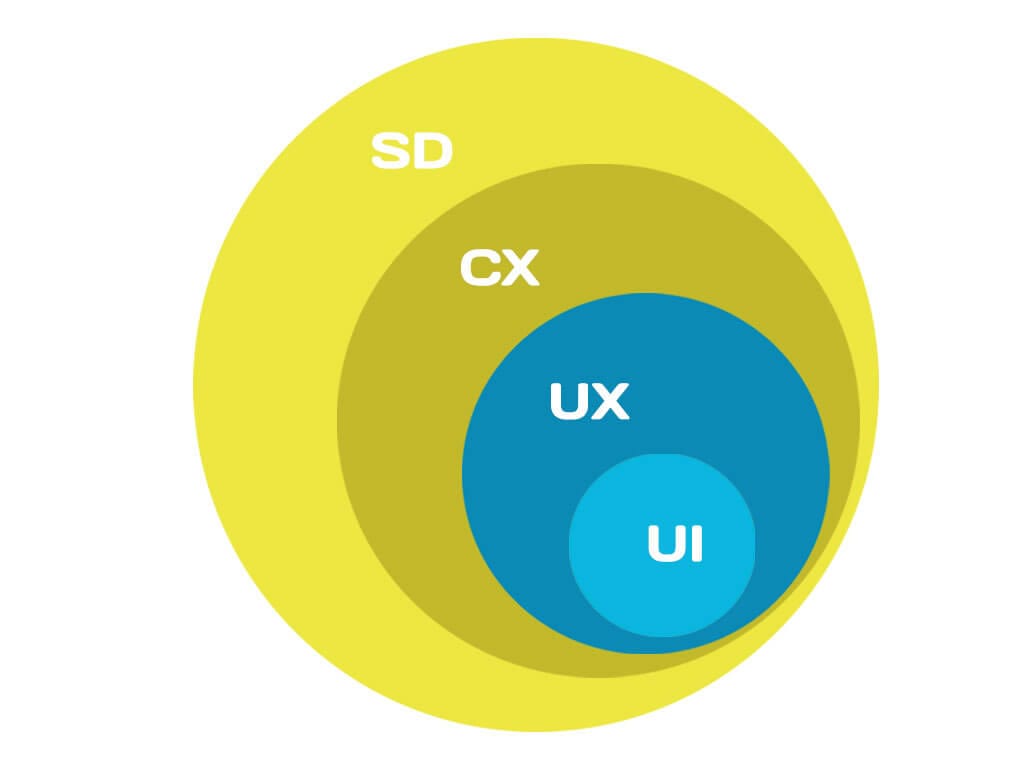
Personas, journey maps, blueprints, wait, this sounds a lot like what you said for UX, and possibly even CX. I’m confused again now.
So, what on earth is Service Design and how does it differ from the others.
Glad you asked (or pretended you asked).
Okay, grab a mop because here is where things get a little messy, so let’s clear things up. Someone enjoyed the party a little too much it seems.
Right, Service Design has been both touted as the big brother to all of CX (and therefore UX and UI), whilst others have banded SD as just another cross-section of CX and UX (but not entirely filling either).
Here’s some diagrams to demonstrate (but likely just to confuse you more).
So let’s get back to the party.
Regardless of whether SD covers all aspects of CX or UX or not, one thing is clear. SD is concerned with ALL stakeholders within a service. Think of SD as an actor-director, or party host, who wants to go around and welcome everyone, but also wants to make sure the processes are running smoothly in the background behind-the-scenes.
Quite the Tarantino.
Consider this example. Let’s say a partygoer got sticky shoes because the floor was, well, too sticky. Okay, UX could ensure that a solution can be fixed there. But, what about the balloons not turning up or the special effect system not working? Sure CX and UX want to ensure the experience is good, but what if something went wrong that has nothing to do with managing the end-user?
SD to the rescue.
SD in my mind is more of the big overall service picture as a whole.
You could take one partygoer for example.
Now a Service Designer would not just concentrate on that users end experience, but consider all the possible touchpoints that could either enhance or endanger that overall experience, including the service interactions of other stakeholders within that journey.
So, in the context of the party, a service designer would not just create a venue and hope people would come. A service designer also wouldn’t necessarily concern themselves with all the marketing and branding efforts to ensure that everyone knew about the party.
They would, however, ensure that the processes involved in the overall service experience were as faultless as they could conceivably be.
Let’s say that partygoer has to use different forms of interaction in their overall journey. They may have to call to book their tickets or get picked up by a dedicated limo to that party. Therefore, a service designer would be interested in those stakeholders too.
Is the booking system efficient? Are there any barriers that can be removed whilst enhancing the service experience? Id social media better or worse than email for sending invitations? Is the limo driver on time and know-how to get to the destination easily?
It’s safe to say, SD is a bit of a perfectionist and has a lot of questions to answer. Maybe they should chill out a bit and enjoy the party too, but they are more like the party organiser who needs to make sure everything is running smoothly.
SD is the big picture guy, which effectively delegates (or hears back from) the likes of UX and UI to ensure the details are taken care of in different areas of the overall service experience. Mic check, 1, 2.
What Is IxD? (Interaction Design)
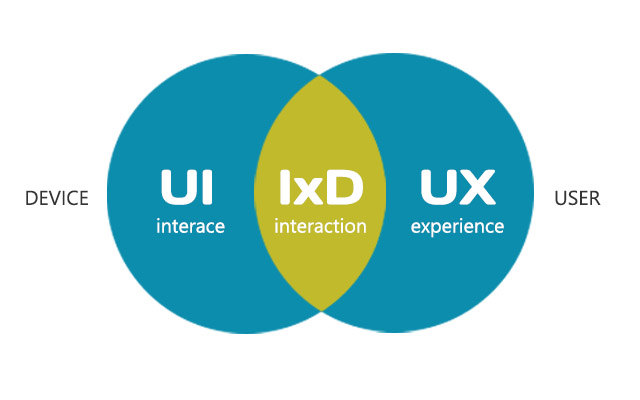
Okay, so finally into what my initial degree was around years ago. Well, it was officially Interactive Design, and it was the first one of its kind all the way back in 2006 (yes, I’m old).
The degree itself focused on many forms of new media (as it was then), and it came before the release of the iPhone and all the touchscreen technology we know today. Back then, Interactive Design was really about how a user would interact with a service or product, and while today that is often focused on digital interactions, the principle is the same.
In today’s world, IxD (as it’s strangely called) is focused more on website and app interactions. It’s probably no coincidence that I fell into both UI and UX roles following my interactive design (and design management) degree, as it tends to be the central core that brings UX and UI together.
It’s like being at the party and UX being introduced to UI by the matchmaker IxD (is that where the little x came from?? ha).
While UX might also focus on user research, user testing, and personas, and UI might buckle down towards more design-orientated aesthetics, IxD is working out how the experience can be more interactive for the end-user.
Think of it as the DJ at the party trying to get the crowd going. On a website that could be the behaviours and buttons the user interacts with, like little animations or sounds, the words used, time, or the devices used to interact.
If you think of how changing simple words from Buy Now to Add To Basket on a button can give Amazon nearly 10% more sales then you can begin to see how this subtle interaction and influence is important.
Left alone, UX without IxD would be like shouting to partygoers through thick glass. They would see UX but wouldn’t really know what she is saying, so she couldn’t really gauge what their experience was like, and UI without IxD would be still in his home making pretty art and not really caring so much about how users could interact with his artwork.
What Is UXD, UED, XD, IA, UCD?
This could be as long as a novel so let’s put the rest in a category called, the rest.
There’s an infinite amount of acronyms these days, ones that come about and go almost as soon as they arrive, such is the need to grab attention with a fancy new term these days.
For the sake of avoiding putting you to sleep then let’s just breeze through the rest of the partygoers here, as lots of the other terms are really just other parts of the main characters we’ve already covered or just a type of process used within the world of experience design.
What Is UXD, UED, XD? ((User) Experience Design)
Head scratching time. But, I’ll save you some stress.
Really, if we want to truly make things easier for ourselves then I would say these are really all the same as UX.
Some may argue that UXD is more of the process (like putting all the parts to an Ikea bed side by side before you make it) and UX is more the emotion or connection (like having the bed put together as a whole), but essentially it’s still a bed.
UXD simply means User Experience Design (as does UED), and XD just means Experience Design (not totally defined to the user).
What I would say, which doesn’t do along with conventional wisdom, but I don’t really like to do that, is that XD could essentially be used to envelope the whole field of experience via design. So all the other acronyms could be put inside it. In that sense, Experience Design is basically the name of the party.
What Is IA? (Information Architecture)
I do wonder why this gets its own bracket sometimes. Information architecture is found within UX too. It’s really just an organisational structure (or blueprint) that can help users find their way easier. As a UX designer, you would consider a site/service/products IA so that you can better under the site’s flow so it can be easily generated into wireframes and sitemaps. It simply makes it easier for a layout to then be decided.
It’s like UX drawing UI a nice map of where to find the cake at the party. IA is best to be thought of as just another element of UX rather than a separate entity itself, as it goes alongside UX jobs such as creating user journeys and personas.
What Is UCD? (User-Centered Design)
User-Centered Design is simply the design process used within experience design. It’s an iterative design process that focuses on the user’s needs in each phase of the process. Whilst it isn’t a job role of a UX designer (such as creating an AI blueprint or a user journey map), it’s more of an overall design process that is used by UX designers to take the user through the experience. It includes the research and design techniques (like personas building and user testing) to create an overview of what types of services or products would be best for the target user.
It’s similar to the design thinking process used by innovators to problem-solve and develop (sprint) new products, services, or solutions that didn’t exist before, but UCD is more focused on the UX designer’s aim of improving the usability of a product or service through crafting a good experience (whether it’s through reinventing the wheel or not).
In terms of the party consider this the party plan.
TLDR Conclusion
Now there are probably more acronyms beyond this, but it gets to the point of becoming silly, and the party gets so loud and troublesome that it gets shut down. Let’s keep it at a manageable level.
Hopefully, the explanations above have helped you but if you do want the TLDR of it all then in party roles here’s how it goes:
UX is the party motivator
UI is the party visual designer
CX is the front-of-house host
SD is the party organiser
IxD is the interactive DJ
UXD/XD is the party name
IA is the party’s treasure hunt game
UCD is the overall party plan.

